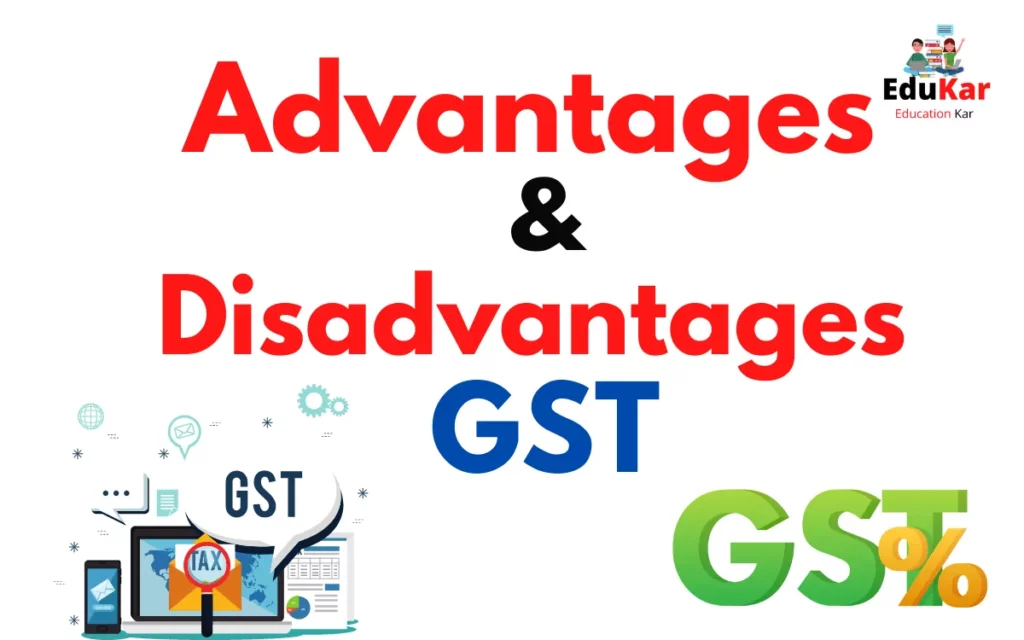Contents
- 1 What is GST?
- 2 Advantages of GST:
- 3 Disdvantages of GST:
- 4 Conclusion:
- 5 FAQs:
- 5.1 What is GST?
- 5.2 What are the advantages of GST?
- 5.3 What are the disadvantages of GST?
- 5.4 How does GST simplify the tax system?
- 5.5 How does GST boost economic growth?
- 5.6 How does GST increase government revenue?
- 5.7 How does GST reduce inflation?
- 5.8 How does GST improve competitiveness?
- 5.9 How does GST enhance transparency?
- 5.10 Can small businesses comply with GST?
Explore the pros and cons of the Goods and Services Tax (GST) in India. Learn about the advantages such as simplicity, transparency, and efficiency, and the disadvantages like compliance, increased cost, and bureaucratic hurdles. Get informed before making a decision.

The Goods and Services Tax (GST) in India has both advantages and disadvantages. Advantages include increased simplicity in the tax system, increased transparency, and improved efficiency in tax collection. GST has also led to a reduction in cascading taxes, leading to lower prices for consumers. On the other hand, the implementation of GST has brought about challenges such as increased compliance costs, bureaucratic hurdles, and higher costs for small businesses. It is important to carefully consider both the benefits and drawbacks of GST before making a decision on its impact on businesses and the economy as a whole.
What is GST?
Goods and Services Tax (GST) is a comprehensive, indirect tax levied on the manufacture, sale, and consumption of goods and services in India. It was introduced in 2017, replacing a multitude of indirect taxes, with the goal of creating a unified national market and simplifying the tax system. GST is based on a multi-stage, value-added tax system, which means that tax is levied on the value added at each stage of production and distribution.
Under the GST system, there are three main tax rates: 5%, 12%, and 18%, with some goods and services being exempt from tax. GST is levied on both intra-state and inter-state supplies of goods and services. The GST council, which consists of representatives from the central and state governments, decides on the tax rates and other aspects of the GST regime.
GST has brought about several changes in the Indian tax system. It has led to increased transparency, as the GST system requires regular filing of returns and the use of a common portal for tax administration. GST has also reduced the cascading effect of taxes, as taxes paid on inputs can be set off against the tax payable on the final product. This has led to lower prices for consumers and increased competitiveness for businesses.
However, the implementation of GST has also brought about some challenges. Small businesses have faced increased compliance costs, as they need to be registered under GST and file regular returns. The bureaucratic procedures associated with GST have also caused headaches for businesses, leading to increased costs and reduced efficiency.
| S.No. | Advantages of GST | Disadvantages of GST |
|---|---|---|
| 1 | Simplifies the tax system and reduces compliance costs. | High tax rates could increase the cost of goods and services, particularly for low-income households. |
| 2 | Reduces the cascading effect of taxes, resulting in lower prices for goods and services. | Implementation challenges, particularly for small businesses, could lead to confusion and errors. |
| 3 | Increases revenue for the government, which can be used to fund public services and infrastructure. | GST may not be as effective in generating revenue for states that rely heavily on other taxes, such as petroleum or alcohol taxes. |
| 4 | Reduces the likelihood of tax evasion and improves tax collection. | The complexity of the tax system could make it difficult for businesses to accurately calculate and report their taxes. |
| 5 | Helps to create a common market, making it easier for businesses to operate across state lines. | The tax system could be regressive, meaning that it places a higher burden on low-income households than on high-income households. |
| 6 | Encourages businesses to operate in the formal sector, which could lead to better working conditions and higher wages for workers. | GST could negatively impact certain sectors, such as the real estate or textile industries, which may see their costs increase. |
| 7 | Promotes exports by making Indian goods and services more competitive in international markets. | The tax system could disproportionately impact certain industries or regions, leading to economic disparities. |
| 8 | Reduces the paperwork and administrative burden associated with multiple taxes. | Small businesses may find it difficult to navigate the tax system and comply with the regulations. |
| 9 | Enables businesses to claim input tax credit, which reduces the overall tax burden. | GST could lead to an increase in inflation, particularly in the short term. |
| 10 | Improves the ease of doing business in India, which could attract more foreign investment. | The implementation of GST could lead to short-term disruptions as businesses adjust to the new tax system. |
Advantages of GST:
- Simplification of tax system: GST replaces multiple indirect taxes with a single tax, making the tax system simpler and easier to understand.
- Increased transparency: Regular filing of returns and use of a common portal for tax administration leads to increased transparency.
- Reduction in cascading effect of taxes: GST allows for the set-off of taxes paid on inputs against the tax payable on the final product, leading to lower prices for consumers.
- Improved competitiveness: The unified national market created by GST makes it easier for businesses to operate across state borders, leading to improved competitiveness.
- Increased tax revenue: The comprehensive nature of GST and increased compliance is expected to lead to increased tax revenue for the government.
- Improved compliance: GST requires regular filing of returns, leading to improved compliance and a reduction in tax evasion.
Disdvantages of GST:
- Complexity: GST involves multiple compliance requirements, making it challenging for businesses, especially small ones, to comply with.
- Technology Dependence: GST relies heavily on technology, and technical issues can cause disruptions and slow down the system.
- Increased Costs: GST may increase the cost of doing business due to the need for compliance and technology upgrades.
- Increased Bureaucracy: GST requires businesses to deal with multiple government agencies, leading to increased bureaucracy and red tape.
- Inadequate IT Infrastructure: The current IT infrastructure in many countries may not be equipped to handle the volume of transactions under GST.
- Revenue Loss for States: Some states may experience a loss of revenue as GST subsumes certain taxes that were previously under their jurisdiction.
Conclusion:
GST is a major tax reform aimed at simplifying the tax system and boosting economic growth. While it offers several advantages such as increased transparency, reduced inflation and improved competitiveness, it also has its own set of challenges such as complexity, increased bureaucracy, and revenue loss for some states. Nevertheless, with proper implementation and the use of technology, GST can bring about a positive impact on the economy and benefit both businesses and consumers.
FAQs:
What is GST?
GST stands for Goods and Services Tax and is a comprehensive indirect tax on the supply of goods and services.
What are the advantages of GST?
GST simplifies the tax system, boosts economic growth, increases government revenue, reduces inflation, improves competitiveness, and enhances transparency.
What are the disadvantages of GST?
The disadvantages of GST include complexity, technology dependence, increased costs, increased bureaucracy, inadequate IT infrastructure, and revenue loss for some states.
How does GST simplify the tax system?
GST replaces multiple taxes with a single tax, making it easier for businesses to understand and comply with.
How does GST boost economic growth?
GST promotes a unified national market, leading to increased economic growth and productivity.
How does GST increase government revenue?
By expanding the tax base, GST leads to increased revenue for the government.
How does GST reduce inflation?
GST helps to reduce the cascading effect of taxes, leading to lower prices and reduced inflation.
How does GST improve competitiveness?
GST makes it easier for businesses to operate across state borders, improving competitiveness and encouraging investment.
How does GST enhance transparency?
GST uses technology to track transactions, reducing the scope for tax evasion and increasing transparency.
Can small businesses comply with GST?
The multiple compliance requirements under GST may pose challenges for small businesses, but with proper support and education, they can comply with GST.
















